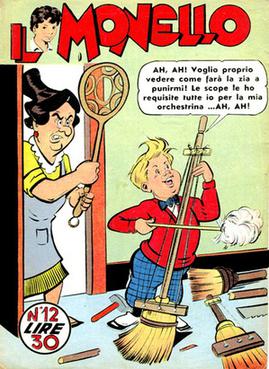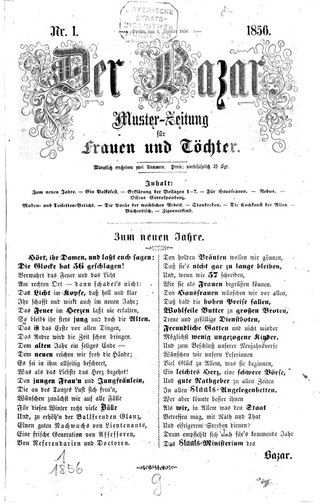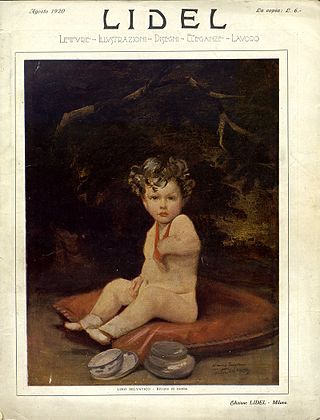Related Research Articles
Famiglia Cristiana is an Italian weekly magazine published in Alba, Italy. The magazine is a Catholic news magazine and has been in circulation since 1931.

Grazia is a weekly women's magazine that originated in Italy with international editions printed in Albania, Argentina, Australia, Bahrain, Bulgaria, China, Croatia, Colombia, France, Germany, Greece, Indonesia, India, Jordan, North Macedonia, Mexico, the Netherlands, Poland, Portugal, Pakistan, Qatar, Serbia, Slovenia, South Korea, Spain, Thailand, and the United Kingdom.
Norsk Ukeblad is a Norwegian language weekly family magazine published in Oslo, Norway. It has been in circulation in 1933.

Il Monello was a weekly comic magazine for kids and teens published in Italy from 1933 to 1990.
Hawaa is a weekly women's magazines published in Cairo, Egypt. The magazine is modelled by other women's magazines in the Arab countries. It was Egypt's first women's magazine, founded in 1954.

Epoca was an illustrated weekly current events magazine published between 1950 and 1997 in Milan, Italy. It was one of the leading magazines during its run.
Me Naiset is a women's magazine published in Helsinki, Finland. It is one of the largest weekly women's magazines in the country and has been in circulation since 1952.
IO Donna is a weekly women's magazine and Saturday supplement of the Italian daily newspaper Corriere della Sera. The magazine is the first supplement of a daily which focuses on women readers. It has been in circulation since 1996 and is based in Milan, Italy.
Novella 2000 is a weekly celebrity and women's magazine published in Milan, Italy. Founded in 1919, it is one of the oldest publications in the country. It is also one of the most read and well-known Italian gossip magazines.
Ottavia Vitagliano was an Italian writer, editor and publisher.

Vie Nuove was a weekly popular magazine published in Rome, Italy, between 1946 and 1978. The magazine was one of the post-war publications of the Italian Communist Party which used it to attract larger sections of the population.
Omnibus was a weekly illustrated general cultural magazine published in Milan, Italy, between 1937 and 1939. Its subtitle was settimanale di attualità politica e letteraria. It is described as the "father of Italian magazines", especially in regard to the use of photographs and images. The magazine was closed by the fascist authorities.
Il Travaso delle idee, mostly known as Il Travaso, was a satirical magazine which was in circulation between 1900 and 1966 with an interruption in the period 1944–1946. Its subtitle was Organo ufficiale delle persone intelligenti. The magazine was headquartered in Rome, Italy.

Der Bazar was a fashion magazine which was published in Berlin, German Empire, in the period 1854–1933. Its subtitle was first Technische Muster-Zeitung für Frauen. Then it was changed to Illustrirte Damen-Zeitung from 1 January 1857. It is one of the earliest examples of a multilingual magazine.
Medina was a weekly women's magazine which was in circulation in the period 1941–1945 in Madrid, Spain. It was one of the publications of Sección Femenina, the women's branch of the Falange political party, which made public the messages of the institution during the much more radical era of the Francoist regime. Its subtitle was Seminario de la SF.

Lidel was a nationalist women's fashion magazine which was in circulation Milan, Italy, in the period 1919–1935. The title was a reference to its founder's name, Lydia Dosio De Liguoro, as well as to the words Letture, illustrazioni, disegni, eleganze, lavori. The magazine played a significant role in the birth of Italian fashion, but at the same time became one of the most militant publications of Fascist Italy.
Riccardo Bauer was an Italian anti-fascist journalist and political figure. He was one of the early Italians who fought against Benito Mussolini's rule. Due to his activities Bauer was imprisoned for a long time and was freed only after the collapse of the Fascist rule in 1943.
Annabella was an Italian women's magazine which existed between 1933 and 1983 with a one-year interruption from 1944 to 1945.

Pattuglia was a weekly communist satirical magazine published between 1948 and 1953 in Milan, Italy. It was official media outlet of the youth organization of the Italian Communist Party. Its subtitle was il corriere dei giovani.
References
- 1 2 3 4 5 6 Manuela Di Franco (April 2018). Popular Magazines in Fascist Italy, 1934 – 1943 (PhD thesis). University of Cambridge. pp. 12, 143, 156, 170, 180. doi:10.17863/CAM.33377.
- 1 2 3 "Beauty on Newsprint". PrintMag. 4 July 2012. Retrieved 21 August 2022.
- ↑ Irene Piazzoni (Summer 2020). "Shaping a Weekly 'For Everyone': Italian Rotocalchi Entre-Deux-Guerres". Journal of European Periodical Studies. 5 (1): 25. doi: 10.21825/jeps.v5i1.16525 . hdl: 2434/761032 . S2CID 225721009.
- 1 2 3 Patrizia Caccia. "Ottavia Vitagliano". Enciclopedia delle donne (in Italian).
- 1 2 3 4 Mitchell V. Charnley (September 1953). "The Rise of the Weekly Magazine in Italy". Journalism Quarterly. 30 (4): 477,480. doi:10.1177/107769905303000405. S2CID 191530801.
- 1 2 Jennifer A. Myers (2011). Everybody's Woman: Gender, Genre, and Transnational Intermediality in Inter-War Italy (PhD thesis). University of Washington. p. 10. ISBN 978-1-124-84509-8. ProQuest 888160875.
- ↑ Maria Antonella Pelizzari (2015). "Make-believe: fashion and Cinelandia in Rizzoli's Lei (1933–38)". Journal of Modern Italian Studies. 20 (1): 47. doi:10.1080/1354571X.2014.973153. S2CID 144013857.